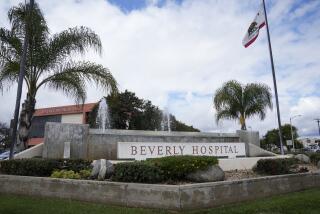Mideast: Losing Ground : The Teaching Hospital
- Share via
The teaching hospital, a critically important element in the American health care system, urgently requires special financing if the future of the institution is to be assured. That is the timely warning emerging from “Prescription for Change,” the report of the Commonwealth Fund’s Task Force on Academic Health Centers.
National health cost-cutting measures now being implemented, however well-intentioned, place at risk the teaching hospital, the task force found. That in turn would jeopardize training of health-care providers of high quality, including doctors, dentists and nurses. It would weaken the care of poor people. And it would handicap clinical research.
The nation requires a new system so that the additional costs associated with teaching hospitals are recognized and paid by all health-care funding sources, including government, insurers, private businesses and individuals, the task force argues. The high costs of teaching hospitals have been covered in the past by the same diversity of sources, but indirectly, through cross-subsidization. Now those subsidies are being cut off by cost-control measures.
Teaching hospitals dramatize one inequity growing out of efforts to contain health costs. Another is in the care of the poor. The report warns that an increasing number of uninsured and underinsured poor are being forced to seek care exclusively in municipal and county hospitals, creating once again a two-tiered system of health services. This is because other acute-care hospitals no longer have funds. That situation should be remedied so that every hospital can care for the poor, including those not covered by the Medicare or Medicaid (Medi-Cal in California), the task force contends.
Solutions are not easy but there are models to follow. There are, for example, two steps that could be taken to assure universal care even for the uninsured poor. They would be to enlarge the eligibility of Medicaid and to establish an all-payers system, already in place in some states, that creates from all providers of health service a fund to cover the costs of caring for the uninsured and underinsured.
The concept of all payers sharing the cost also applies to support for teaching hospitals, the task force argues. Since the benefits are shared by all, so should the cost. At the same time, the task force proposes significant adjustments in graduate medical education. Reduced specialization, and more emphasis on outpatient as distinct from hospital care, are among the recommendations.
The report comes at a critical time because too many cost-cutting decisions have been made without due consideration of the impact on teaching hospitals, on the care of the disadvantaged and on medical education. There surely must be cost containment. But that containment must assure a quality health-care system, equitable care for poor as well as the better-off and continuation of effective medical education.
More to Read
Sign up for Essential California
The most important California stories and recommendations in your inbox every morning.
You may occasionally receive promotional content from the Los Angeles Times.













